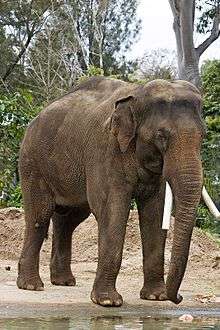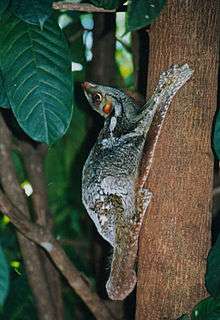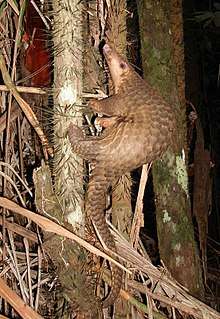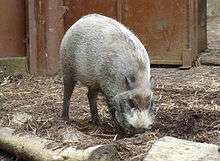List of mammals of Brunei
This is a list of the mammal species recorded in Brunei.[1]
The following tags are used to highlight each species' conservation status as assessed by the International Union for Conservation of Nature:
| EX | Extinct | No reasonable doubt that the last individual has died. |
| EW | Extinct in the wild | Known only to survive in captivity or as a naturalized populations well outside its previous range. |
| CR | Critically endangered | The species is in imminent risk of extinction in the wild. |
| EN | Endangered | The species is facing an extremely high risk of extinction in the wild. |
| VU | Vulnerable | The species is facing a high risk of extinction in the wild. |
| NT | Near threatened | The species does not meet any of the criteria that would categorise it as risking extinction but it is likely to do so in the future. |
| LC | Least concern | There are no current identifiable risks to the species. |
| DD | Data deficient | There is inadequate information to make an assessment of the risks to this species. |
Some species were assessed using an earlier set of criteria. Species assessed using this system have the following instead of near threatened and least concern categories:
| LR/cd | Lower risk/conservation dependent | Species which were the focus of conservation programmes and may have moved into a higher risk category if that programme was discontinued. |
| LR/nt | Lower risk/near threatened | Species which are close to being classified as vulnerable but are not the subject of conservation programmes. |
| LR/lc | Lower risk/least concern | Species for which there are no identifiable risks. |
Subclass: Theria
Infraclass: Eutheria
Order: Proboscidea (elephants)
The elephants comprise three living species and are the largest living land animals.
- Family: Elephantidae (elephants)
- Genus: Elephas
- Asian elephant, Elephas maximus EN
- Genus: Elephas
Order: Sirenia (manatees and dugongs)
Sirenia is an order of fully aquatic, herbivorous mammals that inhabit rivers, estuaries, coastal marine waters, swamps, and marine wetlands. All four species are endangered.
- Family: Dugongidae
Order: Scandentia (treeshrews)
The treeshrews are small mammals native to the tropical forests of Southeast Asia. Although called treeshrews, they are not true shrews and are not all arboreal.
- Family: Tupaiidae (tree shrews)
- Genus: Tupaia
- Long-footed treeshrew, Tupaia longipes EN
- Painted treeshrew, Tupaia picta LR/lc
- Large treeshrew, Tupaia tana LR/lc
- Genus: Tupaia
Order: Dermoptera (colugos)
The two species of colugos make up the order Dermoptera. They are arboreal gliding mammals found in Southeast Asia.
- Family: Cynocephalidae (flying lemurs)
- Genus: Cynocephalus
- Sunda flying lemur, Cynocephalus variegatus LR/lc
- Genus: Cynocephalus
Order: Primates
The order Primates contains humans and their closest relatives: lemurs, lorisoids, monkeys, and apes.
- Suborder: Strepsirrhini
- Infraorder: Lemuriformes
- Superfamily: Lorisoidea
- Family: Lorisidae
- Genus: Nycticebus
- Sunda slow loris, Nycticebus coucang LR/lc
- Genus: Nycticebus
- Family: Lorisidae
- Superfamily: Lorisoidea
- Infraorder: Lemuriformes
- Suborder: Haplorhini
- Infraorder: Tarsiiformes
- Family: Tarsiidae (tarsiers)
- Genus: Cephalopachus
- Horsfield's tarsier, Cephalopachus bancanus LR/lc
- Genus: Cephalopachus
- Family: Tarsiidae (tarsiers)
- Infraorder: Simiiformes
- Parvorder: Catarrhini
- Superfamily: Cercopithecoidea
- Family: Cercopithecidae (Old World monkeys)
- Genus: Macaca
- Crab-eating macaque, Macaca fascicularis LR/nt
- Southern pig-tailed macaque, Macaca nemestrina VU
- Subfamily: Colobinae
- Genus: Presbytis
- Banded surili, Presbytis femoralis LR/nt
- White-fronted surili, Presbytis frontata DD
- Hose's langur, Presbytis hosei DD
- Maroon leaf monkey, Presbytis rubicunda LR/lc
- Genus: Nasalis
- Proboscis monkey, Nasalis larvatus EN
- Genus: Presbytis
- Genus: Macaca
- Family: Cercopithecidae (Old World monkeys)
- Superfamily: Hominoidea
- Family: Hylobatidae (gibbons)
- Genus: Hylobates
- Müller's bornean gibbon, Hylobates muelleri LR/nt
- Genus: Hylobates
- Family: Hominidae (great apes)
- Subfamily: Ponginae
- Genus: Pongo
- Bornean orangutan, Pongo pygmaeus EN
- Genus: Pongo
- Subfamily: Ponginae
- Family: Hylobatidae (gibbons)
- Superfamily: Cercopithecoidea
- Parvorder: Catarrhini
- Infraorder: Tarsiiformes
Order: Rodentia (rodents)
Rodents make up the largest order of mammals, with over 40% of mammalian species. They have two incisors in the upper and lower jaw which grow continually and must be kept short by gnawing. Most rodents are small though the capybara can weigh up to 45 kg (100 lb).
- Suborder: Hystricomorpha
- Family: Hystricidae (Old World porcupines)
- Genus: Hystrix
- Thick-spined porcupine, Hystrix crassispinis LR/nt
- Genus: Trichys
- Long-tailed porcupine, Trichys fasciculata LR/lc
- Genus: Hystrix
- Family: Hystricidae (Old World porcupines)
- Suborder: Sciurognathi
- Family: Sciuridae (squirrels)
- Subfamily: Ratufinae
- Genus: Ratufa
- Cream-coloured giant squirrel, Ratufa affinis LR/lc
- Genus: Ratufa
- Subfamily: Sciurinae
- Tribe: Pteromyini
- Genus: Aeromys
- Black flying squirrel, Aeromys tephromelas LR/lc
- Genus: Pteromyscus
- Smoky flying squirrel, Pteromyscus pulverulentus LR/nt
- Genus: Aeromys
- Tribe: Pteromyini
- Subfamily: Callosciurinae
- Genus: Exilisciurus
- Least pygmy squirrel, Exilisciurus exilis LR/lc
- Genus: Rhinosciurus
- Shrew-faced squirrel, Rhinosciurus laticaudatus LR/lc
- Genus: Sundasciurus
- Horse-tailed squirrel, Sundasciurus hippurus LR/lc
- Genus: Exilisciurus
- Subfamily: Ratufinae
- Family: Sciuridae (squirrels)
Order: Erinaceomorpha (hedgehogs and gymnures)
The order Erinaceomorpha contains a single family, Erinaceidae, which comprise the hedgehogs and gymnures. The hedgehogs are easily recognised by their spines while gymnures look more like large rats.
- Family: Erinaceidae (hedgehogs)
- Subfamily: Galericinae
- Genus: Hylomys
- Short-tailed gymnure, Hylomys suillus LR/lc
- Genus: Hylomys
- Subfamily: Galericinae
Order: Soricomorpha (shrews, moles, and solenodons)
The "shrew-forms" are insectivorous mammals. The shrews and solenodons closely resemble mice while the moles are stout-bodied burrowers.
- Family: Soricidae (shrews)
- Subfamily: Crocidurinae
- Genus: Crocidura
- Southeast Asian shrew, Crocidura fuliginosa LR/lc
- Genus: Crocidura
- Subfamily: Crocidurinae
Order: Chiroptera (bats)
The bats' most distinguishing feature is that their forelimbs are developed as wings, making them the only mammals capable of flight. Bat species account for about 20% of all mammals.
- Family: Pteropodidae (flying foxes, Old World fruit bats)
- Subfamily: Pteropodinae
- Genus: Aethalops
- Pygmy fruit bat, Aethalops alecto LR/nt
- Genus: Balionycteris
- Spotted-winged fruit bat, Balionycteris maculata LR/lc
- Genus: Dyacopterus
- Dayak fruit bat, Dyacopterus spadiceus LR/nt
- Genus: Megaerops
- White-collared fruit bat, Megaerops wetmorei LR/lc
- Genus: Pteropus
- Large flying fox, Pteropus vampyrus LR/lc
- Genus: Pteropus
- White-collared fruit bat, Megaerops wetmorei LR/lc
- Genus: Aethalops
- Subfamily: Macroglossinae
- Genus: Eonycteris
- Greater dawn bat, Eonycteris major LR/lc
- Genus: Eonycteris
- Subfamily: Pteropodinae
- Family: Vespertilionidae
- Subfamily: Kerivoulinae
- Genus: Kerivoula
- Papillose woolly bat, Kerivoula papillosa LR/lc
- Clear-winged woolly bat, Kerivoula pellucida LR/lc
- Painted bat, Kerivoula picta LR/lc
- Whitehead's woolly bat, Kerivoula whiteheadi LR/lc
- Genus: Kerivoula
- Subfamily: Vespertilioninae
- Genus: Glischropus
- Common thick-thumbed bat, Glischropus tylopus LR/lc
- Genus: Hesperoptenus
- Blanford's bat, Hesperoptenus blanfordi LR/lc
- Genus: Hypsugo
- Big-eared pipistrelle, Hypsugo macrotis LR/nt
- Genus: Philetor
- Rohu's bat, Philetor brachypterus LR/lc
- Genus: Pipistrellus
- Kelaart's pipistrelle, Pipistrellus ceylonicus LR/lc
- Narrow-winged pipistrelle, Pipistrellus stenopterus LR/lc
- Genus: Glischropus
- Subfamily: Murininae
- Genus: Murina
- Brown tube-nosed bat, Murina suilla LR/lc
- Genus: Murina
- Subfamily: Kerivoulinae
- Family: Emballonuridae
- Genus: Emballonura
- Small Asian sheath-tailed bat, Emballonura alecto LR/lc
- Genus: Emballonura
- Family: Rhinolophidae
- Subfamily: Rhinolophinae
- Genus: Rhinolophus
- Acuminate horseshoe bat, Rhinolophus acuminatus LR/lc
- Intermediate horseshoe bat, Rhinolophus affinis LR/lc
- Bornean horseshoe bat, Rhinolophus borneensis LR/lc
- Woolly horseshoe bat, Rhinolophus luctus LR/lc
- Lesser woolly horseshoe bat, Rhinolophus sedulus LR/lc
- Trefoil horseshoe bat, Rhinolophus trifoliatus LR/lc
- Genus: Rhinolophus
- Subfamily: Rhinolophinae
Order: Pholidota (pangolins)
The order Pholidota comprises the eight species of pangolin. Pangolins are anteaters and have the powerful claws, elongated snout and long tongue seen in the other unrelated anteater species.
- Family: Manidae
- Genus: Manis
- Sunda pangolin, Manis javanica LR/nt
- Genus: Manis
Order: Cetacea (whales)
The order Cetacea includes whales, dolphins and porpoises. They are the mammals most fully adapted to aquatic life with a spindle-shaped nearly hairless body, protected by a thick layer of blubber, and forelimbs and tail modified to provide propulsion underwater.
- Suborder:Mysticeti
- Superfamily:Balaenopteroidea
- Family:Balaenopteridae
- Genus: Balaenoptera
- Common minke whale, Balaenoptera acutorostrata LC
- Antarctic minke whale, Balaenoptera bonaerensis DD
- Sei whale, Balaenoptera borealis EN
- Bryde's whale, Balaenoptera brydei DD
- Omura's whale, Balaenoptera omurai DD
- Blue whale, Balaenoptera musculus EN
- Fin whale, Balaenoptera physalus EN
- Genus: Megaptera
- Humpback whale, Megaptera novaeangliae LC
- Genus: Balaenoptera
- Family:Balaenopteridae
- Superfamily:Balaenopteroidea
- Suborder: Odontoceti
- Superfamily: Platanistoidea
- Family: Phocoenidae
- Genus: Neophocaena
- Finless porpoise, Neophocaena phocaenoides DD
- Genus: Neophocaena
- Family: Delphinidae (marine dolphins)
- Genus: Feresa
- Pygmy killer whale, Feresa attenuata DD
- Genus: Globicephala
- Short-finned pilot whale, Globicephala macrorhynchus DD
- Genus: Sousa
- Indo-Pacific humpbacked dolphin, Sousa chinensis DD
- Genus: Tursiops
- Common bottlenose dolphin, Tursiops truncatus LC
- Indo-Pacific bottlenose dolphin, Tursiops aduncus DD
- Genus: Tursiops
- Indo-Pacific humpbacked dolphin, Sousa chinensis DD
- Genus: Lagenodelphis
- Fraser's dolphin, Lagenodelphis hosei DD
- Genus: Grampus
- Risso's dolphin, Grampus griseus DD
- Genus: Orcaella
- Irrawaddy dolphin, Orcaella brevirostris DD
- Genus: Orcinus
- Killer whale, Orcinus orca DD
- Genus: Peponocephala
- Melon-headed whale, Peponocephala electra DD
- Genus: Pseudorca
- False killer whale, Pseudorca crassidens DD
- Genus: Stenella
- Pantropical spotted dolphin, Stenella attenuata LC
- Striped dolphin, Stenella coeruleoalba LC
- Spinner dolphin, Stenella longirostris DD
- Genus: Steno
- Rough-toothed dolphin, Steno bredanensis LC
- Genus: Feresa
- Family: Kogiidae
- Genus: Kogia
- Pygmy sperm whale, Kogia breviceps DD
- Dwarf sperm whale, Kogia sima DD
- Genus: Kogia
- Family: Phocoenidae
- Superfamily:Physeteroidea
- Family: Physeteridae (sperm whales)
- Genus: Physeter
- Sperm whale, Physeter macrocephalus VU
- Genus: Physeter
- Family: Physeteridae (sperm whales)
- Superfamily Ziphioidea
- Family: Ziphidae (beaked whales)
- Genus: Indopacetus
- Tropical bottlenose whale, Indopacetus pacificus DD
- Genus: Mesoplodon
- Blainville's beaked whale, Mesoplodon densirostris DD
- Ginkgo-toothed beaked whale, Mesoplodon ginkgodens DD
- Genus: Ziphius
- Cuvier's beaked whale, Ziphius cavirostris DD
- Genus: Indopacetus
- Family: Ziphidae (beaked whales)
- Superfamily: Platanistoidea
Order: Carnivora (carnivorans)
There are over 260 species of carnivorans, the majority of which feed primarily on meat. They have a characteristic skull shape and dentition.
- Suborder: Feliformia
- Family: Felidae (cats)
- Subfamily: Felinae
- Genus: Catopuma
- Bay cat, Catopuma badia EN
- Genus: Pardofelis
- Marbled cat, Pardofelis marmorata VU
- Genus: Prionailurus
- Leopard cat, Prionailurus bengalensis LC
- Flat-headed cat, Prionailurus planiceps VU
- Fishing cat, Prionailurus viverrinus VU
- Genus: Catopuma
- Subfamily: Pantherinae
- Genus: Neofelis
- Clouded leopard, Neofelis nebulosa VU
- Genus: Neofelis
- Subfamily: Felinae
- Family: Viverridae (civets, mongooses, etc.)
- Subfamily: Paradoxurinae
- Genus: Arctictis
- Binturong, Arctictis binturong LR/lc
- Genus: Arctogalidia
- Small-toothed palm civet, Arctogalidia trivirgata LR/lc
- Genus: Paradoxurus
- Asian palm civet, Paradoxurus hermaphroditus LR/lc
- Genus: Arctictis
- Subfamily: Hemigalinae
- Genus: Cynogale
- Otter civet, Cynogale bennettii EN
- Genus: Hemigalus
- Banded palm civet, Hemigalus derbyanus LR/lc
- Genus: Cynogale
- Subfamily: Prionodontinae
- Genus: Prionodon
- Banded linsang, Prionodon linsang LR/lc
- Genus: Prionodon
- Subfamily: Viverrinae
- Genus: Viverra
- Malayan civet, Viverra tangalunga LR/lc
- Genus: Viverra
- Subfamily: Paradoxurinae
- Family: Herpestidae (mongooses)
- Genus: Herpestes
- Collared mongoose, Herpestes semitorquatus LR/lc
- Genus: Herpestes
- Family: Felidae (cats)
- Suborder: Caniformia
- Family: Ursidae (bears)
- Family: Mustelidae (mustelids)
- Genus: Mustela
- Malayan weasel, Mustela nudipes LR/lc
- Genus: Martes
- Yellow-throated marten, Martes flavigula LR/lc
- Genus: Mydaus
- Javan stink badger, Mydaus javanensis LR/lc
- Genus: Mydaus
- Yellow-throated marten, Martes flavigula LR/lc
- Genus: Lutrogale
- Smooth-coated otter, Lutrogale perspicillata VU
- Genus: Aonyx
- Oriental small-clawed otter, Aonyx cinereus NT
- Genus: Mustela
Order: Perissodactyla (odd-toed ungulates)
The odd-toed ungulates are browsing and grazing mammals. They are usually large to very large, and have relatively simple stomachs and a large middle toe.
- Family: Rhinocerotidae
- Genus: Dicerorhinus
- Bornean rhinoceros, Dicerorhinus sumatrensis harrissoni CR
- Genus: Dicerorhinus
Order: Artiodactyla (even-toed ungulates)
The even-toed ungulates are ungulates whose weight is borne about equally by the third and fourth toes, rather than mostly or entirely by the third as in perissodactyls. There are about 220 artiodactyl species, including many that are of great economic importance to humans.
- Family: Suidae (pigs)
- Subfamily: Suinae
- Genus: Sus
- Bornean bearded pig, Sus barbatus LR/lc
- Genus: Sus
- Subfamily: Suinae
- Family: Tragulidae
- Genus: Tragulus
- Lesser mouse deer, Tragulus javanicus LR/lc
- Napu, Tragulus napu LR/lc
- Genus: Tragulus
- Family: Bovidae (cattle, antelope, sheep, goats)
Notes
- This list is derived from the IUCN Red List which lists species of mammals and includes those mammals that have recently been classified as extinct (since 1500 AD). The taxonomy and naming of the individual species is based on those used in existing Wikipedia articles as of 21 May 2007 and supplemented by the common names and taxonomy from the IUCN, Smithsonian Institution, or University of Michigan where no Wikipedia article was available.
References
- "The IUCN Red List of Threatened Species: Mammals of Brunei Darussalam". IUCN. 2001. Retrieved 22 May 2007.
- "Mammal Species of the World". Smithsonian National Museum of Natural History. 2005. Archived from the original on 27 April 2007. Retrieved 22 May 2007.
- "Animal Diversity Web". University of Michigan Museum of Zoology. 1995–2006. Retrieved 22 May 2007.






